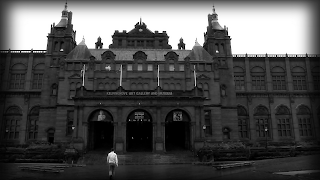To follow on from the previous post, I applied all my textures in my 3ds max scene and rendered out a 32-bit OpenEXR image with an output gamma of 1.0.
OpenEXR's are really good if you want to do any further compositing because all of your render elements are stored in just one files, so it makes file management a lot easier and because they're 32-bit floating point images it means that you can accurately adjust your exposure, gamma and offset in an application like Photoshop of After Effects without getting areas which are completely blown out or getting image stepping - this is in part due to the fact that float point images by their nature have far more values than the standard 8-bit JPEG or PNG so you can be more aggressive with your filters or image adjustments and still get good results. Finally, if OpenEXR's are good enough for ILM to use, I'm sure they're good enough for me to use.
I set the output gamma to 1.0 so that any compositing I'd do would be more accurate, this is because my images are coming out of 3ds max with linear gamma (1.0) meaning that they haven't had any gamma correction already applied to them (say, 2.2 which is the default in 3ds max) so using layer blend modes like Multiply and Add will give better results.
Although I really liked the results I was getting with QuickSilver, I needed fine control over such elements as ambient occlusion and reflections in post-production so I opted to go with mental ray and render out these elements along with a series of Mattes so I could reduce their opactiy and hue and sturation and add colour filters and gamma adjustments. Rendering out Matte passes is much more useful than rendering out and Object ID pass - although it can take longer to setup the Matte passes have the same anti-aliasing as the actual images, so when you apply them as mask they work perfectly without giving any unsightly jagged edges which is typically what you get when using an Object ID or Material ID pass.
I lit my scene with a single Skylight; I was fortunate that when I recorded the video that the CG elements will be placed in, it was a very overcast day with direct light - perfect conditions for applying the Skylight. In my Skylight I applied an HDR image into the environment slot to give me image-based lighting, I also placed this image into the environment map slot of the Environment and Effects window to take care of the reflections.
Here are a few combined images of my colour and matte passes.
I combined these images firstly in Photoshop but then realised that I wanted to make further changes to them in my After Effects composition I'd have to rework and resave the Photoshop image which could be time consuming if I had to do it multiple time. So I redid the image composition in After Effects so that it was quicker to adjust.
Here are two final images, the first one has been colour corrected, blur and grain-matched to blend it with the live footage, the second image has additional filter which were applied to my entire composition including the live action footage.
I'll post a link to the final animation and make another post about the other course work I've done.




No comments:
Post a Comment